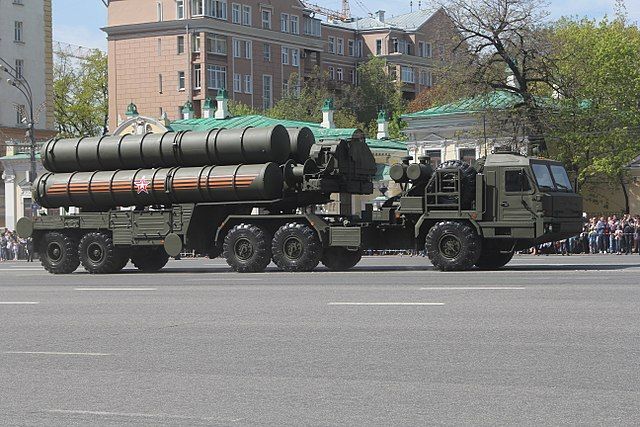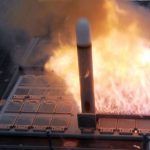Sorting fact from fiction on Russian missile claims
By Pavel Podvig | June 22, 2015
 The Russian S-400 anti-aircraft system, pictured in 2017. Source: Соколрус, via Wikimedia
The Russian S-400 anti-aircraft system, pictured in 2017. Source: Соколрус, via Wikimedia
In early June, the United States released its annual Compliance Report for the year 2015, which assesses whether countries are adhering to their arms control agreements. The report accuses Russia of violating the Intermediate-Range Nuclear Forces (INF) Treaty. Signed in 1987, during the waning days of the Cold War, the treaty eliminated all ballistic and ground-launched cruise missiles—nuclear and conventional—with a range of between 500 and 5,000 kilometers, and prohibited possessing, producing, and testing them.
And yet this is what the United States says Russia is doing. According to the report, Moscow has been working on a ground-launched cruise missile in violation of its treaty obligations. In fact, the United States first publicly made the charge a year ago, in its 2014 Compliance Report, so the contents of the new report shouldn’t come as a surprise. Today, though, the allegation is eliciting unprecedented calls to action.
A few days before the release of this year’s Compliance Report, an Associated Press story cited a report by the office of Gen. Martin Dempsey, chairman of the US Joint Chiefs of Staff, that is said to examine “weapons the U.S. could develop and deploy if freed from INF treaty constraints,” and apparently goes so far as to identify specific weapons systems that the United States might use. Fear over INF Treaty violations seems to be catching on in Europe as well—pressed by journalists, British Foreign Secretary Philip Hammond speculated that the United Kingdom might consider hosting US intermediate-range weapons on its territory.
Comments like these are starting to create an atmosphere of inevitable confrontation, deepening the already existing crisis created by Russia’s actions in Ukraine. Most unfortunately, many news stories and commentaries seem to assume that the accusations of non-compliance mean that Russia is already building its cruise missiles and is poised to target them at Europe and maybe even has already. They give the impression that some yearn for a repeat of the standoff of the 1980s, when the decision to deploy US missiles in Europe in response to the Soviet deployment of its SS-20 missiles eventually forced the Soviet Union to back down and sign the INF Treaty in the first place.
But what may have worked in the 1980s is very unlikely to work today. Before we bring back the Cold War confrontation over intermediate-range missiles in Europe, it would be useful to look at what Russia’s new missiles actually are and, more importantly, what they are not. In the Compliance Reports, the United States deliberately published very little information about the alleged violation of the INF Treaty, giving rise to speculation and numerous theories. Some have suggested that the offending weapons are cruise missiles belonging to the Iskander system, which Russia has been deploying for several years and which it periodically threatens to move close to NATO borders. Others suggest that the problem is the new RS-26 Rubezh ballistic missile, which is probably an intermediate-range missile developed in the guise of an ICBM. However, neither of these is the culprit.
Even though the information on the violation is extremely thin, we can say with high certainty that the system in question is a long-range cruise missile that is being developed for deployment on submarines. The INF Treaty does not prohibit development and deployment of sea-launched cruise missiles, even though for all practical purposes the same missiles could easily be deployed on land. The treaty also allows the parties to test their sea-launched cruise missiles from land, as long as the trials are conducted from a fixed launcher at a site that is used solely for testing. And here is where Russia came into conflict with the treaty: It either tested its cruise missile from a launcher that is not “fixed,” or from one that was used for another purpose at some point. Neither of these concepts is clearly defined in the treaty and although they seem self-explanatory, there is some room for interpretation and disagreement.
Why Russia would conduct tests that are not fully treaty-compliant is not entirely clear. It may be that the tests did not go through a thorough compliance review and nobody saw a potential conflict. Maybe Russia has its own understanding of what a fixed launcher is or what you can use a launcher for. It is also possible that Russia did test the cruise missile from a mobile launcher, knowing full well that this kind of test would violate the INF Treaty. However, while such a deliberate breach cannot be completely ruled out, given all the evidence we have, an inadvertent technical violation of the treaty seems much more likely.
One might think that the US government, having gone public with the allegation of non-compliance, adds some weight to the theory of a grave deliberate violation. Not necessarily. The Obama administration quite possibly would have preferred to resolve the issue quietly through diplomatic channels, but once it became known that the State Department was conducting its own internal compliance review—prior to the public release of the 2014 Compliance Report—members of Congress and others put serious pressure on the administration to confront Russia about the alleged violation. There was a clear advantage in doing so: Russia had contemplated leaving the INF Treaty in the past, but after a public accusation of non-compliance, the political cost of doing so would be much higher.
To a certain extent, Washington’s tactic worked—Russia responded to the US Compliance Report by officially stating that it remains firmly committed to the treaty and has no intention of leaving. However, for things to stay that way, the United States and Russia will have to find a way to address the current non-compliance dispute. That could be extremely difficult.
To begin with, Russia has yet to own up to the actions that created the current situation. It insists that the United States has not provided it with enough information to rebut the accusations and that as far as it is concerned, no violation has ever taken place. It is true that the United States did not go into much detail about the charges, mostly to protect its methods and sources, but probably also to force Russia into disclosing more information about its tests. At the same time, even though the United States did not name the specific weapon system or the test dates, we know that it did provide Russia with enough information to identify the tests and the systems of concern. At this point, Russia is clearly playing for time while it contemplates its next step.
The problem is that regardless of whether the tests in question were deliberate or inadvertent violations, they cannot be undone. The treaty is rather strict on this point—one test is all it takes for its provisions to kick in. Then, all missiles and launchers of the type that were tested fall under the scope of the treaty. This means that if Russia is to “return to verified compliance,” on which the United States insists, it would have to eliminate all of them, including, for example, missiles that may have been built for deployment on submarines. That is a very tall order, so it is not surprising that Russia wants to think twice before admitting anything.
To be clear, none of the Russian missiles in question have been deployed yet. This is what the United States told its allies last year and it is apparently still the case. The US administration seems committed to a diplomatic resolution to the dispute, and indeed there are ways to reach an agreement that would be acceptable to both sides. However, a diplomatic solution would require quite a bit of good will and trust, which are almost completely absent from today’s United States-Russia relationship.
Meanwhile, the rhetoric surrounding the issue—from experts, the media, and occasionally officials in Russia and the West—seems to be getting out of control, as people start assuming the worst and speaking as if we were about to see a major military standoff in Europe with hundreds if not thousands of potentially nuclear intermediate-range missiles pointed in both directions. This kind of posturing would be extremely unhelpful in the best of times, and we could certainly live without it in this very difficult period, when there are plenty of other issues to deal with. It would make sense for both sides to calm down and at least stop escalating this particular dispute.
Most of the solution is in Russia’s hands. Despite Moscow’s claims to the contrary, it has enough information to open a meaningful technical discussion with the United States about what actually happened at the test site. Accepting that there is an issue to discuss does not mean admitting any wrongdoing. Stonewalling, on the other hand, will only make the situation worse and will definitely not help Russia win any friends.
The United States could also help calm the situation down. This does not mean, of course, that it should let the issue go. It is understandable that the US administration believes it has to be tough with Russia—if there has ever been a time to show resolve it is probably now. Besides, a violation is a violation and there is nothing wrong with continuing to press Russia about compliance. But at this point it would be wise for Washington to reveal more details about the accusations and say clearly that Russia is not pointing its missiles at Europe. This alone would bring much-needed sanity to the discussion. And it would certainly help to reassure the public that the military options the United States has discussed are purely hypothetical at this point. Doing so may help make sure they stay that way.
Together, we make the world safer.
The Bulletin elevates expert voices above the noise. But as an independent nonprofit organization, our operations depend on the support of readers like you. Help us continue to deliver quality journalism that holds leaders accountable. Your support of our work at any level is important. In return, we promise our coverage will be understandable, influential, vigilant, solution-oriented, and fair-minded. Together we can make a difference.
Share: [addthis tool="addthis_inline_share_toolbox"]














